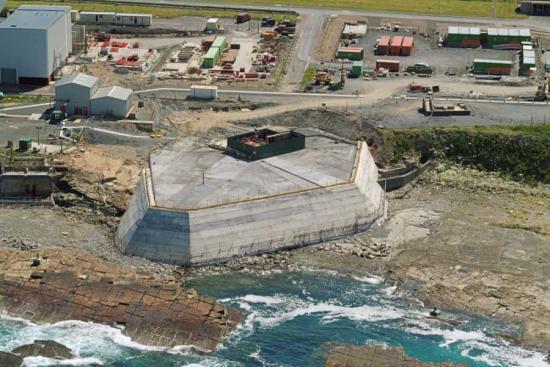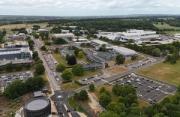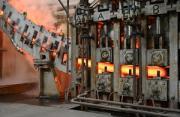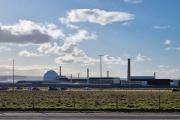Isolation Of Dounreay's Shaft Commences
26th January 2007

Dounreay has started drilling up to 400 boreholes around the site's waste shaft in the biggest step so far towards its eventual clean-out.
Grout will be injected through the boreholes to seal fissures in the rock around the 65 metre deep shaft and so create a giant containment barrier in the shape of a boot around the shaft that will isolate the radioactive waste from groundwater.
The project - the first of its kind in the world - will prevent large volumes of groundwater flowing into the shaft during waste retrieval and becoming contaminated. It will also reduce the risk of leakage from the shaft in the interim.
The work is being carried out by UKAEA on behalf of the Nuclear Decommissioning Authority and follows agreement by regulatory authorities.
UKAEA's Warren Jones, shaft isolation senior project manager, said: "Decommissioning the waste shaft is one of the biggest clean-up challenges in the world today, so I am delighted that we have now commenced this important phase of work to clean it out."
The boreholes will be drilled in stages in a boot shape around the shaft, with constant monitoring to provide assurance that each stage has been completed successfully.
The change from an oval grout curtain to a boot shape evolved last year following trials by the project team at Dounreay. It was realised a boot shape would be more efficient because it limits the internal surface area of the grout curtain and so helps to minimise the volume of water entering the shaft after construction.
Prior to the construction of the grout curtain, 12,000 tonnes of concrete was poured to create a raised working platform at the top of the shaft. A plug at the base of the shaft, which separates it from a sub-sea tunnel carrying the site effluent discharge pipe, was reinforced and a section of the tunnel infilled.
Isolation of the shaft has commenced four years earlier than previously planned and is expected to take between two to four years to complete. The �16 million isolation contract was awarded to Ritchies, the specialist geotechnical division of Edmund Nuttall Ltd, and the total cost of this phase of the shaft decommissioning is �27 million.
Once complete, isolation is expected to improve safety and environmental conditions during waste retrieval operations. The timescale for this is the subject of discussion with regulators and the NDA about funding availability.
A video telling the history of the shaft, its isolation and showing how it could be emptied was screened for the first time to members of the Dounreay Stakeholder Group on Wednesday 24 January 2007.
The DVD is also available on the UKAEA website and copies are available from the site.
See http://www.ukaea.org.uk/sites/dounreay_site_video.htm
Retrieving the waste from the shaft is one of the most complex decommissioning jobs. Concept designs for removing the waste are still being developed, evaluating what techniques can be utilised, what equipment is needed and how this is operated to successfully retrieve the waste from the shaft and silo. This project is to provide retrieval equipment, a treatment and packaging plant and interim intermediate level waste storage. The footage gives an indication of the plans being proposed.
Steve Efemey, UKAEA's shaft retrieval project manager, said: "We are still in the concept design phase of this project and some significant alterations have been made since the DVD was produced, however it does give some insight into how we intend to approach this incredibly complex project."
During construction of the subsea effluent tunnel at Dounreay in the 1950s, a 65-metre vertical shaft was excavated to remove the spoil. Following the completion of the tunnel, the shaft was plugged at the base and authorised by the Scottish Office for the disposal of solid intermediate-level waste. The last disposal took place in 1977 prior to an explosion.
A detailed independent assessment of this work was carried out by the Scottish Environment Protection Agency. SEPA's agreement to proceed followed UKAEA's response to recommendations in the report, which can be found at
http://www.sepa.org.uk/pdf/radioactivity/dounreay/Dounreay_shaft_technical_assessment.pdf
Related Businesses
Related Articles
UKAEA develops 3D printing for fusion components
At its recently opened Central Support Facility (CSF), UKAEA has commissioned an electron beam additive manufacturing machine that can be used to incorporate tungsten into components, alongside a selective laser manufacturing machine. Fusion can play a key role in a global low carbon energy future.Advancing Fusion Remote Maintenance: Industry Collaboration Driving Innovation
As part of the Fusion Futures (FF) programme, UKAEA's Remote Applications in Challenging Environments (RACE) has partnered with industry leaders to develop two groundbreaking technologies for remote maintenance in fusion energy engineering. Thanks to FF funding, industry has taken the lead in maturing UKAEA technology concepts—delivering real-world solutions that enhance operational autonomy and reduce maintenance burdens in extreme environments.UKAEA launches International Fellowships Scheme for fusion
UKAEA has launched the International Fellowships Scheme, an initiative to help expand the global talent pool supporting the fusion industry. The scheme is part of the UKAEA's Fusion Opportunities in Skills, Training, Education and Research (FOSTER) Programme, which aims to train, support, and empower the next generation of professionals, who will help deliver fusion power to the grid.Kyoto Fusioneering and Astral Systems join Culham fusion hub
UKAEA's Culham Campus welcomes Kyoto Fusioneering and Astral Systems as its latest tenants. Two pioneering companies, Kyoto Fusioneering and Astral Systems, have joined the growing cluster of fusion technology and AI organisations at United Kingdom Atomic Energy Authority's (UKAEA) Culham Campus.
Fusion-grade Steel Produced At Scale In UK-first
Researchers achieve 10x production cost savings for reduced activation steel. A United Kingdom Atomic Energy Authority (UKAEA) working group has successfully demonstrated the industrial scale production of fusion-grade steel.
UKAEA To Lead The Creation Of A Robotics And AI Cluster
UKAEA will lead the creation of a new £4.9m nuclear robotics and artificial intelligence cluster across Cumbria and Oxfordshire. The robotics and AI cluster was announced by UK Research and Innovation (UKRI) as one of seven new projects to kickstart economic growth and address regional needs: www.ukri.org The robotics and AI cluster will link Cumbria and Oxfordshire to accelerate the decommissioning of the UK's legacy nuclear fission facilities and keep people out of hazardous environments.
Diamonds Are Forever? World-first Carbon-14 Diamond Battery Made In Uk
The world's first carbon-14 diamond has been produced with the potential to provide power for thousands of years. Scientists and engineers from the UK Atomic Energy Authority (UKAEA) and the University of Bristol have successfully created the world's first carbon-14 diamond battery.
UKAEA Monthly Newsletter Latest Edition
Find out what has been happening at UKAEA in our monthly newsletter. Read about our recent activities and upcoming events.
UKAEA Newsletter - Edition 11 Published Today
Find out what has been happening at UKAEA in our monthly newsletter. Read about our recent activities and upcoming events.
Corwm Visits Dounreay Nuclear Site
Members were given an overview of the scale of the problem and challenges faced in the decommissioning of the site. In the last week of March 2024, several members of CoRWM led by the Chair, Sir Nigel Thrift, made the long journey up to the North of Scotland to visit the Dounreay nuclear site, now managed by Nuclear Restoration Services.
